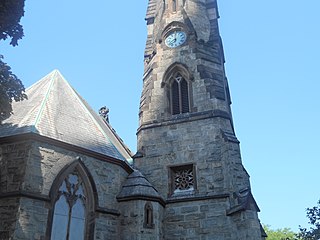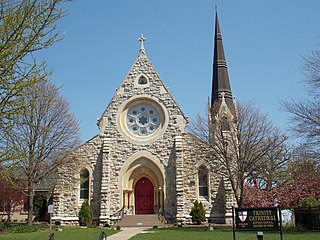Related Research Articles

The Metropolitan Community Church of Toronto is a congregation of the worldwide Metropolitan Community Church movement located in Toronto, Ontario, Canada and is a welcoming congregation openly affirming lesbian, gay, bisexual, heterosexual and transgender people. MCC Toronto was instrumental in changing the law on same sex marriage in Ontario, when two same-sex marriage ceremonies performed at the church on January 14, 2001 initiated the process leading to the Halpern v Canada (AG) decision of 2003.

The Reconciling Ministries Network (RMN) is an organization seeking the inclusion of people of all sexual orientations and gender identities in both the policy and practices of United Methodist Church. It is one of many Welcoming Congregation organizations to emerge in American Christianity in the 1980s. The ministry has over 1100 affiliated congregations and 42,000 affiliated individuals.

St. Michael's Church is a historic Episcopal church at 225 West 99th Street and Amsterdam Avenue on Manhattan's Upper West Side in New York City. The parish was founded on the present site in January 1807, at that time in the rural Bloomingdale District. The present limestone Romanesque building, the third on the site, was built in 1890–91 to designs by Robert W. Gibson and added to the National Register of Historic Places in 1996.

Trinity-St. Paul's Episcopal Church in New Rochelle in Westchester County, New York was added to the National Register of Historic Places in 2006. It is located at the northwest corner of Huguenot Street and Division Street. This church represents the body of the majority group of New Rochelle's founding Huguenot French Calvinistic congregation that conformed to the liturgy of the established Church of England in June 1709. King George III gave Trinity its first charter in 1762. After the American Revolutionary War, Trinity became a parish of the Protestant Episcopal Church of America.

Trinity Church, on Queen Anne Square in Newport, Rhode Island, is a historic parish church in the Episcopal Diocese of Rhode Island. Founded in 1698, it is the oldest Episcopal parish in the state. In the mid 18th century, the church was home to the largest Anglican congregation in New England.

St. Thomas' Parish is an Episcopal church in Washington, D.C. It is part of the Diocese of Washington.
Redeemer Lutheran Church is a congregation of the Lutheran Church–Missouri Synod (LCMS) in Elmhurst, Illinois, a western suburb of Chicago. Founded in 1928, there were 495 baptized members. Three of Redeemer's pastors held rather long tenures; Rev. Worth Setzer served for nearly 31 years, Rev. George Bornemann for 17 years, Rev. Richard Drews for 26 years. Rev. Robert Fitzpatrick served for 7 years. Moreso recently, Rev. Scott Stiegemeyer served at Redeemer for five years; the current pastor is Rev. Anthony Oliphant, who was installed in the autumn of 2015.

The Historic Trinity Lutheran Church is a church located in downtown Detroit, Michigan. It occupies the Trinity Evangelical Lutheran Church complex, located at 1345 Gratiot Avenue. It was designated a Michigan State Historic Site in 1981 and listed on the National Register of Historic Places in 1983. Its current pastor is Rev. Darryl L. Andrzejewski.

St. Paul's Episcopal Church is a parish of the Episcopal Church in Cleveland Heights, Ohio. The current rector is the Rev. Jeanne Leinbach, installed on October 23, 2015. She is the first female rector of St. Paul's. Her predecessor was the Rev. Alan M. Gates, who served from 2004–2014, before his election as Bishop of Massachusetts. St. Paul's is a leading church and has the largest congregation in the Episcopal Diocese of Ohio.

Holy Trinity Episcopal Church also known as Holy Trinity Memorial Church is an historic Episcopal church building located at 38 Grand Avenue in the village of Swanton, Franklin County, Vermont. Built in 1876 and expanded in 1909-10, the church facilities include a fine example of the Carpenter Gothic in the older section, and the Late Victorian Gothic Revival in the newer section. The church was listed on the National Register of Historic Places as the Parish of the Holy Trinity in 2001. The church is an active parish in the Episcopal Diocese of Vermont; its current rector is the Rev. Reid D. Farrell.

Trinity Church is a historic Episcopal congregation located at 33 Mercer Street in Princeton, New Jersey. It is the largest Episcopal church in New Jersey.

Trinity Episcopal Cathedral, formerly known as Grace Cathedral, is the historic cathedral in the Diocese of Iowa. The cathedral is located on the bluff overlooking Downtown Davenport, Iowa, United States. Completed in 1873, Trinity is one of the oldest cathedrals in the Episcopal Church in the United States. It was individually listed on the National Register of Historic Places in 1974. In 1983 the cathedral was included as a contributing property in the College Square Historic District, which is also listed on the National Register.

Trinity Cathedral is a historic church on Euclid Avenue at East 22nd Street in Cleveland, Ohio. It is the cathedral of the Episcopal Diocese of Ohio.

Trinity Episcopal Church is a parish church in the Diocese of Iowa. The church is located in Muscatine, Iowa, United States. It was individually listed on the National Register of Historic Places in 1974. In 2006 it was included as a contributing property in the Downtown Commercial Historic District.

St. Paul's Episcopal Church is a parish church in the Diocese of Iowa. The church is located in Durant, Iowa, United States. The church building and parish hall have been listed on the National Register of Historic Places since 1985.
Trinity Episcopal Church is a parish church of the Episcopal Church of the United States located at 213 1st Ave., NW in Winchester, Tennessee, USA, and affiliated with the Episcopal Diocese of Tennessee.

Trinity Episcopal Church is a historic church at 703 West 3rd Avenue in Pine Bluff, Arkansas. Its congregation meets in a handsome brick Gothic Revival structure, with a square buttressed tower and buttressed side walls with lancet-arched stained glass windows. The church was built 1866-70 for a church congregation organized in 1860 by the Rev. Robert Trimble. Initially named St. John's, it was renamed Trinity after Trimble received guidance from members of the Trinity Church in New York City. It is unique in Arkansas as having a burial chamber under its chancel; it is that of early parishioner Cornelia Bell Roane, who died in 1862. It is an active member of the Episcopal Diocese of Arkansas.

Trinity-St. James United Methodist Church is located in Cedar Rapids, Iowa, United States. The congregation began as a Sunday school in the northwest part of the city organized by Trinity Methodist Episcopal Church. The evangelist Billy Sunday had preached a revival there and over 300 people joined the church. St. James Methodist Episcopal Church, as it was then known, was established shortly afterward in February 1910. The congregation originally used the closed Danish Lutheran Church at K Avenue NW and Fourth Street NW for their services, and they moved the building that summer to Ellis Boulevard NW. St. James grew to the point that a new building was needed. In 1945 property across the street was purchased, and local architect William J. Brown designed the new church facility. Construction began in September 1952 and it was completed in April 1954 for $165,000.
LGBT culture in St. Louis is strongly influenced by larger regional divisions, such as racial division and the city/county divide. Recorded history and resource flow have tended to prioritize white individuals and the city's central corridor, creating a perception of LGBT culture in St. Louis that does not always align with regional demographics. For the purposes of this article, St. Louis describes the metropolitan area, including neighboring counties in Missouri and Illinois.
References
- 1 2 3 4 Batza, Katie; Diedriech, Michelle. "National Register of Historic Places Registration Form: Trinity Episcopal Church" (PDF). National Park Service . Retrieved February 4, 2020.
- ↑ Shepley, Michael (January 29, 2020). "St. Louis church becomes first Episcopal parish included in national historic register for LGBTQ advocacy". Episcopal News Service. Retrieved February 4, 2020.